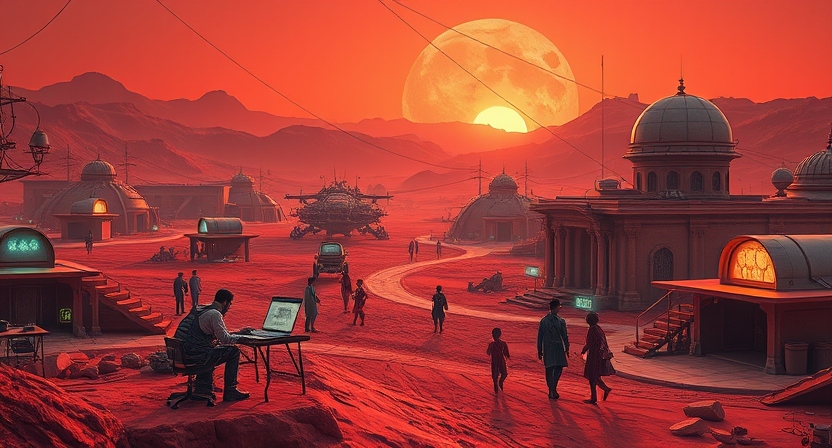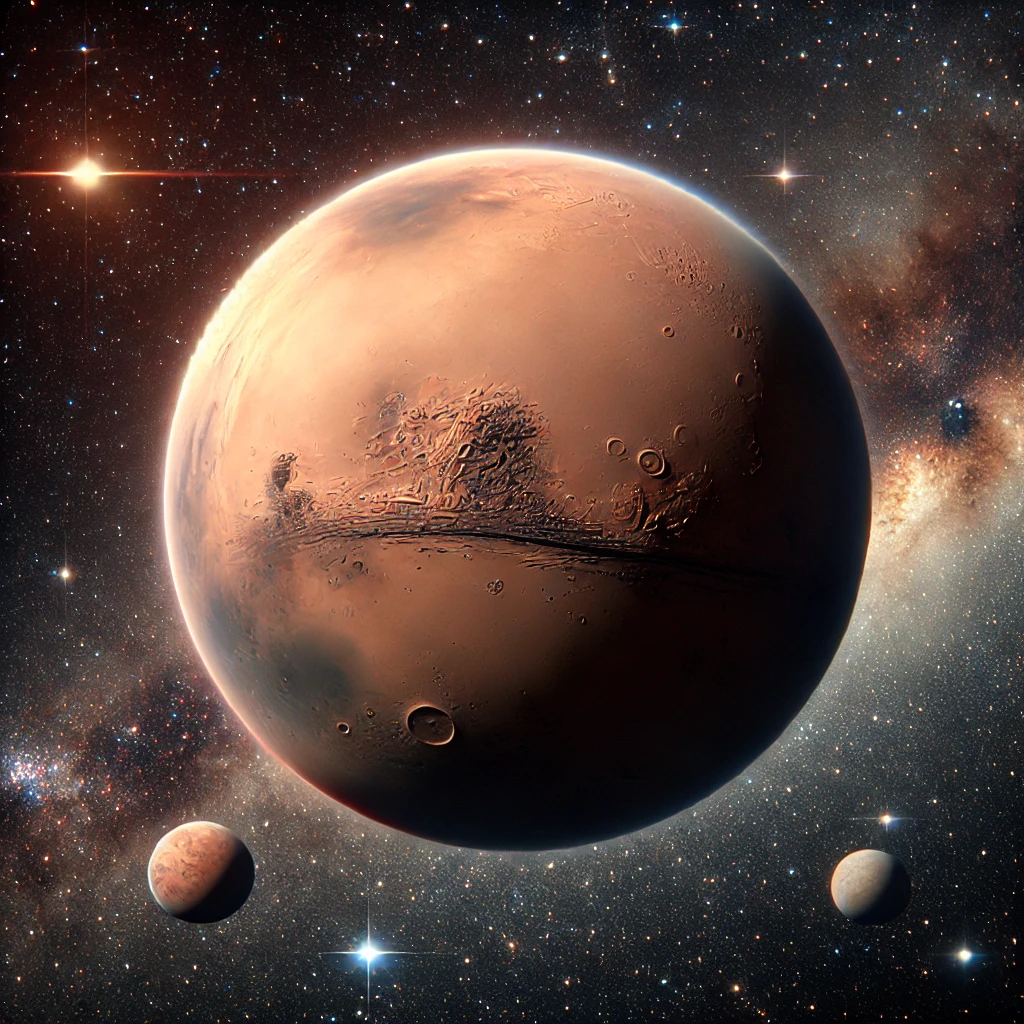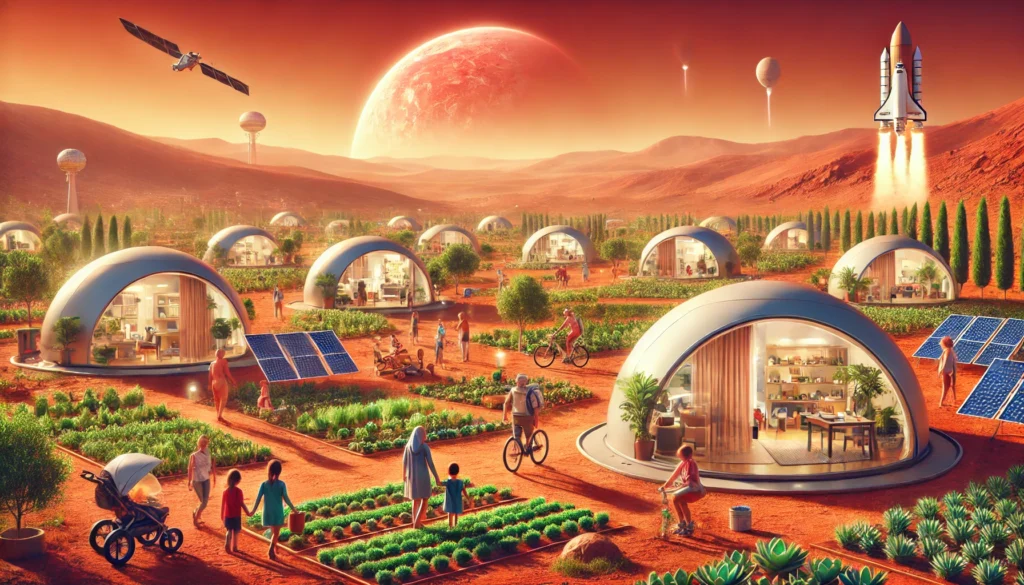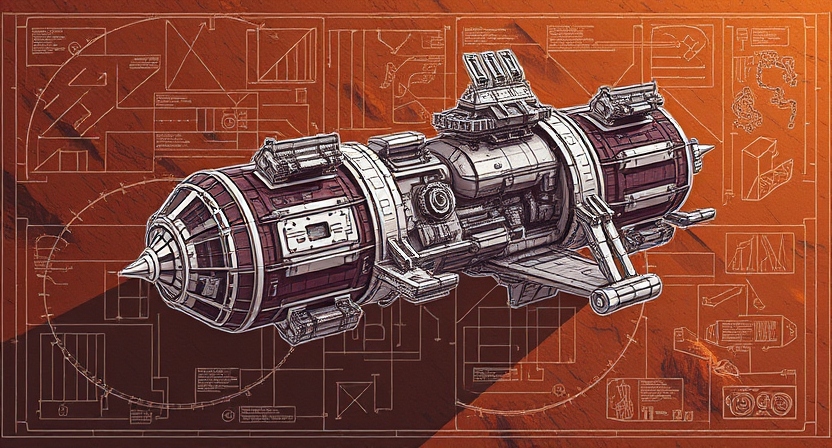Civilization on Mars

Introduction
“Someday people will travel to Mars. It will be a long trip, but, this will be a big step for mankind. We would be able to find out if there was life on this planet. It probably will look like a red desert” – a statement by J. Stephen Hartsfield, Seventh Grader, 1984 and also you may have heard Elon Musk saying “ If everyone is going to die someday then why
not die on Mars”. So, today in this article we will discuss about Mars and Martian civilization.
Table of Contents
About Mars

Mars, often called the “Red planet”, is the fourth planet from the Sun and one of Earth’s closest planetary neighbor.
Mars has a diameter of about 6,779km (4212 miles), which is roughly half the size of Earth. Its mass is about 10% of Earth’s, making its gravitational pull weaker; standing on Mars, you would experience about 38% of the gravity you feel on Earth. Its reddish appearance comes from Iron Oxide (rust).
If we talk about its atmosphere, then, there is no breathable oxygen, minimal water vapor. Mar’s atmosphere is thin and consists mostly CO2 (95.3%), with traces of Nitrogen (2.7%) and Argon (1.6%).
The surface pressure on Mars is about 610 pascals, which is less than 1% of Earth’s atmospheric pressure.
So, how human life is possible on Mars?
How to establish a civilization on Mars ?
Starting a civilization on Mars is difficult because it is about starting a new life on a new planet. It will require a lot of money, technology and resources. In terms on capital it may reach to trillions of dollars which will be more than the GDPs of all countries combined.
There are estimations that by 2050, we are able to make a settlement on Mars but I think it will take us more than a century to full civilize Mars.
But as you know, technological innovations and development is a game changing factor as it is indispensable.
- To reduce the cost of Civilization, space technology should become much cheaper. It will only become possible if more space companies came into existence. This will significantly reduce the cost of space travel.
- Innovation in the fields of technology may give us a green flag to establish a civilization on Mars.
- Companies and governments should invest in Research and development in different sectors such as farming, medicine, resource extraction ETC, to unlock the tech which we can use on Mars. This is only attainable through frequent inventions and discoveries.
- Establish a civilization on Mars requires considering various factors, one of them is massive dust storms on Mars that use to cover the entire planet and last for weeks and sometimes, months. So there has to be a strategy or planning to tackle such calamities.
- Some scientists have proposed the idea of ‘Terraforming’ Mars to make it ‘Earth like’, including generating a thicker atmosphere to allow liquid water. But it is only theoretical.
Civilizing Mars is, indeed, an interesting thing to do for humans so that they can finally declare themselves ‘Multi-planetary’. But it comes with its own benefits and challenges.
Benefits of Civilizing Mars

- Scientific Discovery – Mars is one of the few places in our solar system where life may have existed, so studying it could help us learn more about Earth’s past and future.
- Technological advancement – Exploring Mars could lead to new technologies that help humans travel and explore beyond Earth. For example, the Mars Oxygen Experiment (MOXIE) converts Martian carbon dioxide into oxygen, which could help humans live and work on Mars.
- Resource utilization – Space exploration could help us discover new resources, such as rare elements and minerals, that could be used in manufacturing and product design.
- Human evolution – Colonizing Mars could be a milestone in human evolution, combining scientific inquiry, survival strategy, and technological prowess.
- Cultural inspiration – Mars has captured the imagination of space-faring societies and has been explored in art, film, and science fiction writing.
- International cooperation – Colonizing Mars could be a collaboration between different countries, representing a step in international cooperation.
Whatever have positives, will also have negatives as well. Continue reading. . .
Challenges of Living on Mars

Life on another planet might be very different in Chemistry, structure and other characteristics. So civilizing on Mars or
any other planet is distinctive, than civilizing on Earth. Here are some challenges that humans are facing –
- Radiation – Mars has a thin atmosphere and no global magnetosphere, which means the surface is exposed to high levels of radiation from the sun and cosmic rays. This radiation can cause health issues like cancer, radiation sickness, and genetic damage.
- Dust Storms – Mars is known for its planet-wide dust storms that can last for months and cover the entire surface.
- Temperature – Mars experiences extreme temperature fluctuations, ranging from mild to well below freezing.
- Atmospheric pressure – Mars’s atmospheric pressure is much lower than Earth’s, averaging around 600 pascals (0.087 psi).
- Distance from Earth – Mars is very far from Earth, which makes resupply missions difficult and expensive.
- Gravity – Mars’s gravitational force is about 38% of Earth’s.
- Psychological challenges – The isolation and confinement of a Mars settlement could cause significant psychological challenges.
- Mental health – Mental health is a challenge that people face on Earth, and it could be even more difficult on Mars.
- Landing – The thick atmosphere of Mars makes it difficult to land a spacecraft safely using parachutes alone..
Technologies needed for Mars civilization

As I stated earlier that only technological advancement can make civilization on Mars possible. So, there are technologies we need in order to fulfill our mission of becoming multi planetary species. Here are some technologies that we need in order to begin –
1. Advanced Propulsion Systems – Propulsion systems must be capable of long duration space travel along with many other features.
2. Advanced Spacesuits – Martian conditions require space suits providing life support, radiation, and mobility.
3. Communications – Laser communications tech can used to send large amount of real-time data.
4. In situ resource utilization – In situ resource utilization system can help humans to utilize Mars resources.
5. Inflatable heat shield – To land astronauts on other planets.
6. Landing equipment – Landing safely on Mars requires pin point accuracy for safe zones and near pre positioned resources.
7. Life support systems – Sustaining human life on Mars requires robust life supporting systems to meet their basic necessities of air, water and food.
8. Martian home and lap on wheel – To reduce the number of items needed to land on the surface, NASA will combine the first Martian home and vehicle into a single entity.
9. Nuclear Energy – Mars is very energy poor, so it will require nuclear fission to generate energy.
10. Radiation Shielding – Cosmic radiation poses a major risk to astronaut health during the long journey and on the Martian surface.
11. Uninterrupted power – Astronauts need a reliable power supply to explore Mars.
These are some of the basic technologies we need to begin our new lives on Earth. But still these are not enough because as we advance towards more complex settlement ideas, we need more advance technologies.
How will humans farm on Mars?

To make a civilization on Mars, exporting foods and resources from Earth will be very expensive and time taking. So humans have to farm on Mars for their long term survival which will help them to explore the planet and also find different ways to improve their livelihood. Here are some ideas about how humans will farm on Mars.
1. Soil-free techniques: Hydroponics and Aeroponics are soil-free methods that can be used to grow plants in
nutrient-rich water. These methods can be used to grow a wide variety of plants, including tomatoes, lettuce, potatoes, and cucumbers.
2. Synthetic biology: Creating crops that are better adapted to Martian conditions.
3. Altering plant architecture: Re-engineering how plants harvest energy.
4. Using microbes: Yeast and algae are ideal candidates because they are nutritious, reproduce rapidly, and take up far less space than traditional crops.
5. Intercropping: Growing plants with properties that could help each other grow. This method makes the best use of resources including water and nutrients.
6. Using leftover plant parts to create soil: Every part of a plant that is not eaten will be used to gradually create soil.
7. Using chemical plants: Chemical plants could use some of the compounds found on Mars to create plastics that might be used to build shelters, greenhouses, vehicles and high-tech potting systems for growing food.
Will humans survive long term on Mars?
Right now, it may not be possible to live long on Mars. Mars has different characteristics. If it is possible, then humans require complex support systems to survive on Mars.
Right now, many organization are in the move of researching and exploring, so that they can understand whether Mars is habitable for humans or not.Mars is very different from Earth in terms of Atmosphere, temperature, gravity, chemistry and radiation.
Also organs can rupture on Mars of we try to stay there for long due to lack of atmospheric pressure, which can cause air in a person’s lungs to expand rapidly.
This can lead to lung rupture and death unless the air is exhaled immediately. There are other effects on body such as Ebuilism, Hypoxia, radiation effects on muscles and bones, and effects on the vascular system. Most probably, only 2 minutes a human can survive on Mars.
Conclusion
Out of everything, making a civilization on Mars is really an ambitious project. Obviously, it comes with its benefits and
challenges but it also shows the advancing or exploring nature of humans.
Civilizing Mars will be a good way to save humanity from extinction. This shows the “Out of the box” thinking capabilities of humans and also their curiousness towards starting a whole new world on a different planet, i.e., Mars.
In future, humans will be the dominating species in our solar system or if possible, in our Milky Way Galaxy.

